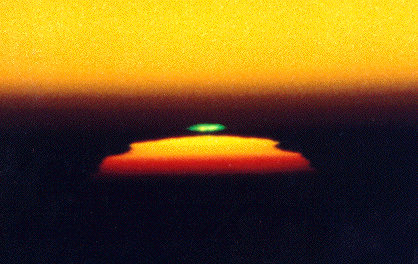
Photograph by Andrew T. Young taken from Torrey Pines, California on Jan. 7, 1996 *

Photograph by Andrew T. Young taken from Torrey Pines, California on Jan. 7, 1996 *
When the Sun sets, sometimes the last bit of light from the top of the disk itself is an emerald green color. The same is true of the first bit of light from the rising Sun. This phenomenon is known as the "green flash" or "green ray." It is not an "optical illusion." It does not fill the sky with green light.
The green flash is quite common and will be visible any time the Sun is rising or setting on a *clear*, *unobstructed*, and *low* horizon. From an observatory at Mt. Hopkins, the sunset green flash can be seen probably 90% of the evenings that have no visible clouds on the western horizon. It typically lasts one or two seconds (by estimate, not stopwatch).
The explanation for the green flash involves refraction, scattering, and absorption.
First, the most important of these processes is refraction. Sunlight is bent in the atmosphere with the net effect that the visible image of the Sun at the horizon appears roughly a solar diameter *above* the geometric position of the Sun. That is, if there were no atmosphere, the actual disk of the Sun would already be completely below the horizon. The atmosphere, however, actually does cause the "image" of the Sun to appear to be visible, approximately one solar diameter above the horizon.
The "image" you now see of the Sun at sunset on Earth is entirely caused by the atmosphere!
|
Refraction of white light through a medium such as water, glass, or air causes different wavelengths of light to be refracted at different angles. Blue light with shortest wavelengths is refracted the most. Red light with longest wavelengths is refracted the least. Thus, the Sun's image in red light would appear to be "lower" in the sky than the image of the Sun in blue light. This can be confirmed by placing red and blue filters over a telescope which would allow only those wavelengths to be visible. |
|
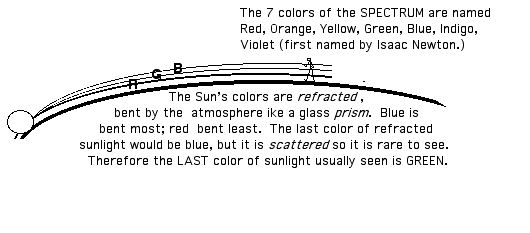
Now scattering: the blue light is Rayleigh scattered away (not Compton or Thomson scattered). The size of the atoms of gases in the air cause light of blue wavelengths to be scattered, or diffused, more than other colors. This explains "Why the sky is blue."
Then absorption: air has a very weak absorption band in the yellow. When the Sun is overhead, this absorption hardly matters, but near the horizon, the light travels through something like 38 "air masses," so even a weak absorption becomes significant. A setting Sun no longer appears as yellow/white as a mid-day Sun
Finally, a simple explanation for the green flash is thus,
(1) Refraction separates the solar images by color;
(2) At just the right instant, the red/orange image of the sun has set,
(3) The yellow image is absorbed; and
(4) The blue image is scattered away.We are left with the upper limb of the Sun which has a residual green image.
However, if you are very lucky, you may actually see the last bit of the refracted colors to include a bit of blue!
_ _ _ _ _ _ _ _ _ _ _ _ _ _ _ _ _ _ _ _ _ _ _ _ _ _ _ _ _ _ _ _ _
_ _ _ _ _ _ _ _ _ _ _ _ _
Above text by Steve Willner <swillner@cfa.harvard.edu>; and Geoffrey A. Landis, <geoffrey.landis@lerc.nasa.gov>; and expanded by Bruce C. Belknap <bcbelknap@redshift.com> . Two original line diagrams generated with AppleWorks draw module by Bruce C. Belknap, 4-AUG-98.
_ _ _ _ _ _ _ _ _ _ _ _ _ _ _ _ _ _ _ _ _ _ _ _ _ _ _ _ _ _ _ _ _ _ _ _ _ _ _ _ _ _ _ _ _ _
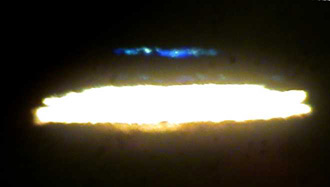 |
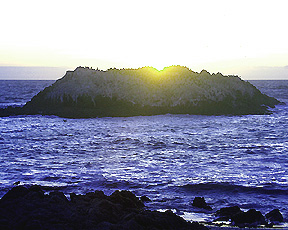 |
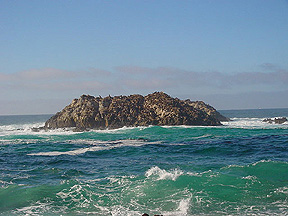 |
|
"Rodney took these great snaps of the blue/green flash using a digital camera through a 200mm telescope." See similar photos at http://astro.uchicago.edu/home/web/gd1/flash.html |
Even when the Sun is fully above the horizon, a green flash can be seen when the last remnant of the Sun's upper limb dispapears behind an artificial horizon. Bruce C. Belknap witnessed a very brief green flash through a dip in the upper surface of Bird Rock immediately following this photograph on April 7, 2003, The Sun's image was merging into a layer of local fog, about as thick as solar diameter above the horizon. |
This is a midday photo of Bird Rock along the coast of Pebble Beach in Monterey County as taken from a lower vantage point along the beach. This famous landmark lies about 500 yards off the coastline. During Fall it is actually covered with California Sea Lions. During Spring it is home to nesting Cormorants. |
* More information about Andrew T. Young's research and photography.
|
<> <> <> <> <> <> <> <> <> <> <> <> <> <> <> <> <> <> <> <> <> <> <>
Frequently Asked Questions about time, calendars, and and related terrestrial phenomena can be found at: http://sciastro.astronomy.net/
More details can be found in The Green Flash and Other Low Sun Phenomena, by D. J. K. O'Connell, and in the classic Light and Color in the Open Air. A refraction table appears in Astrophysical Quantities, by C. W. Allen. Andrew Young has provided a list of reading material at http://mintaka.sdsu.edu/GF/reading.html.
An interesting notion and an unusual activity-- possible sighting
of a green flash from the setting of the planet Venus--is described
on a web page of the Sudekum Planetarium, Nashville, TN, at http://www.sudekumplanetarium.com/features/2001/01-03greenflash.shtml
"By taking a few steps backward to maintain the angle made
by the roof, he was able, again and again, to create a green flash of
Venus. He found he could also produce it by gently stooping."
A Green Flash from the Sun
Credit & Copyright: J. C. Casado
Explanation: Many think it is just a myth. Others think it is true but its cause isn't known. Adventurers pride themselves on having seen it. It's a green flash from the Sun. The truth is the green flash does exist and its cause is well understood. Just as the setting Sun disappears completely from view, a last glimmer appears startlingly green. The effect is typically visible only from locations with a low, distant horizon, and lasts just a few seconds. A green flash is also visible for a rising Sun, but takes better timing to spot. A slight variant of this can be caught in a photograph, where much of the Sun is still visible, but the very top appeared momentarily green. The Sun itself does not turn partly green, nor does the sky durn green. The effect is caused by layers of the Earth's atmosphere which causes the sky to appear to be blue.
<> <> <> <> <> <> <>
<> <> <> <> <> <> <>
<> <> <> <> <> <> <>
<> <>
"The sun can be distorted in the most amazing ways: it splits up into slices; it looks almost square when it sets; the disc of the sun takes on the shape of a Chinese lantern; after it has actually set, the sun may sometimes float above the horizon as a needle-thin strip for 10-15 minutes before finally disappearing; the sun may have the shape of a pot, a peaked cap, a vase, a cauldron, an atom bomb... On the surface of the sun, dark sunspots may be vertically elongated into dark columns or double like ordinary mirages. At sunset it is possible to see anything! Some people may be familiar with one of Nature's most exciting surprises: sometimes the very last ray of the setting sun is bright green, a pure, metallic shade of green which would be considered utterly mendacious if a painter dared to include it in his painting. Jules Verne has written an entire novel on the theme of this green flash (Le Rayon vert). It is said that whosoever sees it shall never be short of luck in love! Surely that alone is a good enough reason to go looking for mirages on the horizon?"
|
The paragraph (above) was written by Pekka Parviainen. Many hundreds of his solar images can be seen at http://www.polarimage.fi/ This is one of his video sequences
with |
 |
Return to Coastal Web Weaver Homepage
April 2003